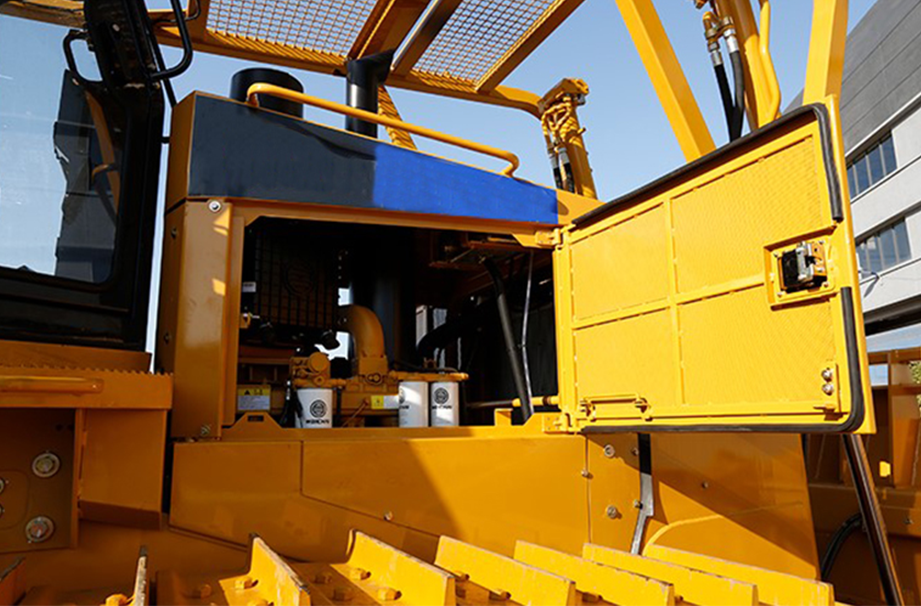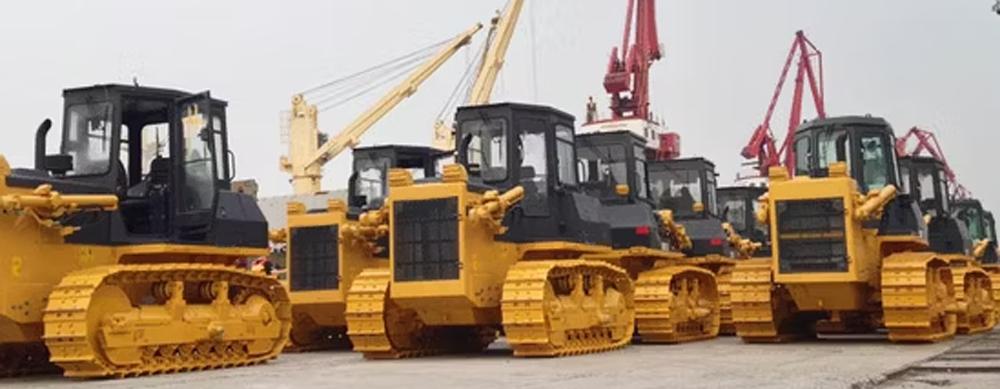Sanitation bulldozers are specialized heavy machinery designed to handle waste and debris in sanitation operations. These bulldozers feature a robust and durable build, typically with a powerful engine that provides ample thrust. Their wide, reinforced blades are engineered to efficiently push large volumes of trash, rubble, or snow, depending on the application. The tracks offer excellent traction, enabling them to operate on various terrains, from muddy landfill sites to slippery roads. The operator's cabin is designed for comfort and safety, with good visibility and ergonomic controls. Sanitation bulldozers play a crucial role in maintaining clean environments, making waste management tasks more efficient and less labor-intensive.
| Pictures |
|
|
|
| General parameters | |||
| Model | 818F | SEM822D | 824F |
| Equipment type | Sanitation type | Sanitation type | Sanitation type |
| Operating weight (kg) | 20010 | 28560 | 28000 |
| Climbing capacity (°) | 30 | 30 | 30 |
| Ground Specific Pressure (kPa) | 31 | 39 | |
| Power range | 120-220kW | 120-220kW | 120-220kW |
| Power Type | Fuel | Fuel | |
| Engine | |||
| Model | WP7G200E472 | WP10HG270E471 | |
| Flywheel power (kW) | 147 | 183 | 211 |
| Rated speed (r/min) | 2200 | 2200 | |
| Emission standard | Euro 4 | Euro 4 | |
| Dimension | |||
| Track plate width (mm) | 950 | 915 | 915 |
| Track Ground Length (mm) | 3025 | 3488 | |
| Minimum Turning Radius (mm) | 3870 | 4300 | |
| Minimum Ground Clearance (mm) | 400 | 400 | |
| Transmission system | |||
| Model | Dual, closed, electrically controlled hydrostatic transmission | Dual, closed, electrically controlled hydrostatic transmission | |
| Steering Brake | Wet Multi-Plate Brakes | Wet Multi-Plate Brakes | |
| Number of supporting wheels (single side) (pcs) | 7 | 8 | 8 |
| Number of sprockets (single side) (pcs) | 2 | 2 | 2 |
| Travel speed 1st gear (forward/reverse) (km/h) | 0~10 | 0~10 | |
| Number of track plates | 42 | 45 | |
| Shoveling device | |||
| Model | Sanitation shovel | Sanitation shovel | Sanitation shovel |
| Shovel capacity (m³) | 8.2 | 12.7 | |
| Spade width | 4229 | 4400 | |
| Spade Height (mm) | 1585 | 1945 | |
| Maximum lifting height (mm) | 1120 | 1165 | |
| Maximum depth of cut (mm) | 510 | 665 | |
| Maximum tilt (mm) | 397 | 640 |

1. Structure and Material: Usually made of a sturdy steel structure, such as using flange steel on the top and bottom, and enclosing with steel plates on both sides, and multiple reinforcing ribs are welded to enhance structural stability.
2. Bulldozing Blade: The core component of the working device, mainly used for pushing and leveling garbage and other materials. It consists of parts such as the front cutter, side cutter, bottom plate, and push rod.
3. Scraper Blade: Used for loading and unloading garbage materials, generally composed of parts such as the bucket, shovel rod, and hydraulic cylinder.
4. Traveling Device Components: The track is the main component, which supports the weight of the bulldozer and transmits power, enabling the bulldozer to travel on various complex sanitary operation sites.
5. Engine: The power source of the sanitation bulldozer, providing power for the working device and traveling device of the bulldozer.
6. Transmission System: Includes components such as the gearbox, drive shaft, drive axle, drive wheel, differential, and clutch.
7. Hydraulic System: Used to transmit and regulate the power output by the engine to drive the movement of working devices such as the bulldozing blade and scraper blade.
8. Control System: Comprises components such as controllers, sensors, and switches. The controller precisely controls the engine, hydraulic system, etc.

1. Engine Power: The engine is the heart of the bulldozer. For handling large volumes of waste or debris in extensive sanitation areas like big landfill sites or large-scale waste management projects, a bulldozer with a high-horsepower engine, typically in the range of 150 to 300 horsepower or more, is preferable.
2. Push Capacity: Look at the rated push capacity of the bulldozer's blade. This indicates how much weight and volume of waste it can move at one time.
3. Blade Type: There are different types of blades available. A straight blade is good for general pushing and leveling tasks in waste areas.
4. Blade Size: Consider the width and height of the blade. A wider blade can cover a larger area in one pass, increasing work efficiency when dealing with large expanses of waste.
5. Turning Radius: In areas with limited space like urban waste collection points or small waste treatment facilities, a bulldozer with a small turning radius is crucial.
6. Overall Dimensions: The size of the bulldozer should fit the work environment. A smaller bulldozer can access narrow alleys and cramped spaces, but might have less power and a smaller blade.
7. Cab Visibility: Good visibility from the operator's cab is essential for safe and efficient operation. The design of the cab should allow the operator to clearly see the blade, the front, sides, and rear of the bulldozer.
8. Ease of Maintenance: Check how accessible the engine, hydraulic system, and other key components are for routine maintenance and repairs. A well-designed layout with easy-to-open panels and service points can save time and reduce downtime.

Sanitation bulldozers are constructed with heavy-duty materials to withstand the harsh conditions of waste management. The frame is typically made of high-strength steel, reinforced in critical areas to handle the constant impact and abrasion from pushing debris, trash, and other solid waste.
Equipped with a potent engine, usually diesel-powered, these bulldozers generate significant horsepower and torque. This power is essential for moving large volumes of waste efficiently.
The blades of sanitation bulldozers are designed with waste handling in mind. They are wider and often have a curved or angled shape to better scoop up and push waste.
The operator's cab is designed to provide maximum visibility. It has large, clear windows and multiple mirrors strategically placed to give a comprehensive view of the surroundings.
A reliable hydraulic system powers the movement of the blades and other attachments. It allows for precise control of the blade's elevation, tilt, and extension.
Sanitation bulldozers can operate on a variety of terrains. Whether it's muddy landfill sites, gravelly waste storage areas, or paved roads during snow removal operations, their tracks and suspension systems provide the necessary stability.
The interior of the operator's cab is designed for comfort. It features an adjustable seat with good lumbar support to reduce fatigue during long shifts.
